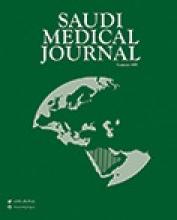Abstract
OBJECTIVE: The aim of this study is to determine the prevalence of insulin resistance syndrome among type-II Saudi diabetics.
METHODS: The study involved type-II Saudi diabetics followed at the Out-patient Clinic of King Abdul-Aziz University Hospital, Jeddah, Kingdom of Saudi Arabia, from January 1997 to December 1998. Their age, sex and body mass index was recorded. Serum samples were analyzed for glucose. Insulin C-peptide level and insulin glucose index was calculated. Serum cholesterol, high density lipoproteins, low density lipoproteins, triglyceride, and uric acid were measured.
RESULTS: A total of 109 patients were studied, (67 females and 42 males) with an age range from 28 to 105 years. Median body mass index was 27 in males and 30.2 in females. Percentage of male and female patients with the following abnormalities were as follows: Total cholesterol >5.3mmol/L (47.6% males, 40.9% females), high density lipoproteins-cholesterol <1.2mmol/L (71.4% males, 40.9% females), low density lipoproteins-cholesterol >3.4mmol/L (42.8% males, 37.9% females), triglyceride >2.3mmol/L (40.5% males, 31.8% females), insulin >24mIU/l (23.8% males, 29.7% females), C-peptide >1324 pmol/L (21.2% males, 13% females) and hypertension (33.3% males, 43.8% females). Uric acid >420umol/L was found in 35.5% males and >390umol/L in 25.6% females. Body mass index >27.8 was found in males (35.7%) and >27.3 in females (67.7%). Insulin resistance as defined by insulin glucose index >5.4 was found in 19.8% of the study group (23.8% males, 15.9% females). Insulin resistance syndrome was found in 16.5% (17.1% males, 15.9% females).
CONCLUSION: Insulin resistance syndrome is common among type-II Saudi diabetics.
- Copyright: © Saudi Medical Journal
This is an open-access article distributed under the terms of the Creative Commons Attribution-Noncommercial-Share Alike 3.0 Unported, which permits unrestricted use, distribution, and reproduction in any medium, provided the original work is properly cited.






